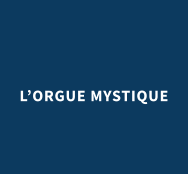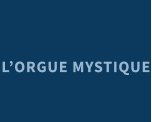L’ORGUE MYSTIQUE
The thirties in France mark an abundance of organ composition. Paris was regarded the Eldorado of the organ world of those days inside and outside France. Many Paris churches had monumental organs and famous players. In the list of Paris organists Charles Tournemire is one of the most important innovators of the French romantic organschool. Many twentieth century organ composers in France and abroad have been strongly influence by him. The organ improvisations of Tournemire played during or after Mass in the Paris Sainte Clotilde drew the attention of organ students of Marcel Dupré at the Paris Conservatorium: André Fleury, Olivier Messiaen, Gaston Litaize, Jean Langlais. Jean- Jacques Grünenwald. Jehan Alain. Marcel Dupré primarily taught the development of virtuosity. In Tournemire’s music intimacy and musicality are most important. His virtuosity was instrumental in het Catholic liturgy. It is not surprising that the young Olivier Messiaen felt very attracted to the style of Tournemire. In numerous letters he shows his admiration for ‘the master of arabesque’, as he called Tournemire. Also srong;y if;uenced were Tournemire’s students Maurice Duruflé, the Belgian Flor Peeters and the Dutchman Maius Monnikendam.
Tournemire thought liturgy to be the most important aspect of his
task as an organist. His improvisations during Mass therefore
were based on the Gregorian melodies belonging to the particular
Sunday or principal feast. It was Joseph Bonnet, organist of the
Paris St. Eustache and formed by Alexander Guilmant, who,
inspired by these improvisations, incited Tournemire to compose
his monumental liturgical cycle L’Orgue Mystique.
This work consists of paraphrases of Gregorian melodies for
Sundays and principal feasts of the liturgical year in three cycles:
the Christmas Cycle, the Easter Cycle and the Cycle after
Pentecost, divided into 5 offices, each having the same structure:
Prélude à l’introit - Offertoire - Elévation - Communion - Pièce
terminale
It took Tournemire 5 years to complete this Magnus opus (1927-
1932). In it, he merged the symphonic, impressionistic style of
organ music with liturgy. His musical language is very varied. We
find interludes, rondos, fantasias, paraphrases, chorals and, most
of all, variations. With L’Orgue Mystique, Tournemire place himself
wll within the tradition of Couprein, De Grigny, Nivers and others.
Although L’Orgue Mystique was especially intended for liturgical
use, the composer points out in his introduction that it can also be
played at recitals.
(texte: Tjeerd van der Ploeg)


L’ORGUE MYSTIQUE


The thirties in France mark an abundance of organ
composition. Paris was regarded the Eldorado of the organ
world of those days inside and outside France. Many Paris
churches had monumental organs and famous players.
In the list of Paris organists Charles Tournemire is one of the
most important innovators of the French romantic
organschool. Many twentieth century organ composers in
France and abroad have been strongly influence by him.
The organ improvisations of Tournemire played during or
after Mass in the Paris Sainte Clotilde drew the attention of
organ students of Marcel Dupré at the Paris
Conservatorium: André Fleury, Olivier Messiaen, Gaston
Litaize, Jean Langlais. Jean-Jacques Grünenwald. Jehan Alain.
Marcel Dupré primarily taught the development of
virtuosity. In Tournemire’s music intimacy and musicality are
most important. His virtuosity was instrumental in het
Catholic liturgy. It is not surprising that the young Olivier
Messiaen felt very attracted to the style of Tournemire. In
numerous letters he shows his admiration for ‘the master of
arabesque’, as he called Tournemire.
Also srong;y if;uenced were Tournemire’s students Maurice
Duruflé, the Belgian Flor Peeters and the Dutchman Maius
Monnikendam.
Tournemire thought liturgy to be the most important aspect
of his task as an organist. His improvisations during Mass
therefore were based on the Gregorian melodies belonging
to the particular Sunday or principal feast. It was Joseph
Bonnet, organist of the Paris St. Eustache and formed by
Alexander Guilmant, who, inspired by these improvisations,
incited Tournemire to compose his monumental liturgical
cycle L’Orgue Mystique.
This work consists of paraphrases of Gregorian melodies for
Sundays and principal feasts of the liturgical year in three
cycles: the Christmas Cycle, the Easter Cycle and the Cycle
after Pentecost, divided into 5 offices, each having the same
structure:
Prélude à l’introit - Offertoire - Elévation -
Communion - Pièce terminale
It took Tournemire 5 years to complete this Magnus opus
(1927-1932). In it, he merged the symphonic, impressionistic
style of organ music with liturgy. His musical language is
very varied. We find interludes, rondos, fantasias,
paraphrases, chorals and, most of all, variations. With
L’Orgue Mystique, Tournemire place himself wll within the
tradition of Couprein, De Grigny, Nivers and others.
Although L’Orgue Mystique was especially intended for
liturgical use, the composer points out in his introduction
that it can also be played at recitals.
(texte: Tjeerd van der Ploeg)



















